Wisconsin may not be the first state you think of when it comes to biodiversity. But the state is home to a spectacular variety of over 130 caterpillar species on their way to becoming butterflies or moths. Yet, amidst these colorful and often beneficial creatures lurk a few that can pose a threat to the unsuspecting enthusiast. Some of them harbor toxins that can cause skin irritation or allergic reactions.
In this article, we will explore the 15 of the most intriguing caterpillars found in Wisconsin, pointing out the ones that you should steer clear of. Stay cautious and informed as you explore the rich biodiversity of Wisconsin’s ecosystem.
1. Pipevine Swallowtail Caterpillar (Battus philenor)

These unique caterpillars are black with orange spikes. Keep your distance as they are toxic.
©Sundry Photography/Shutterstock.com
Pipevine swallowtails are common caterpillars throughout Wisconsin. Their larvae are black, featuring red spikes and markings along their spines, which makes them less appealing to potential predators.
These caterpillars, also known as blue swallowtails, have a specific diet consisting solely of the leaves from birthworts and Dutchman’s pipes (Aristolochia plants). So, to attract these butterflies to your garden, consider planting some birthwort vines.
It’s vital to know that the pipevine swallowtail caterpillars and butterflies are highly poisonous. If ingested by a person or animal, it can lead to serious health issues.
2. Baltimore Checkerpost Caterpillar (Euphydryas phaeton)

This is the beautiful butterfly of the Baltimore checkerspot caterpillar. A common caterpillar to find in Wisconsin.
©bookguy/iStock via Getty Images
In its caterpillar stage, the Baltimore checkerspot exhibits a black head, complemented by a black and bright yellow striped body in a repeating pattern. The caterpillar also features spiny outgrowths along the vibrant bands.
You can commonly find these creatures in damp open fields where their preferred food, the turtlehead plant, thrives. Moreover, they frequently venture to neighboring higher grounds to feed on the nectar from milkweeds, black-eyed susans, thistles, or other available nectar-rich plants.
It is essential to note that this is another variety of poisonous caterpillars in Wisconsin. The host plants that this caterpillar consumes make it toxic!
3. Cloudless Sulphur Caterpillar (Phoebis sennae)
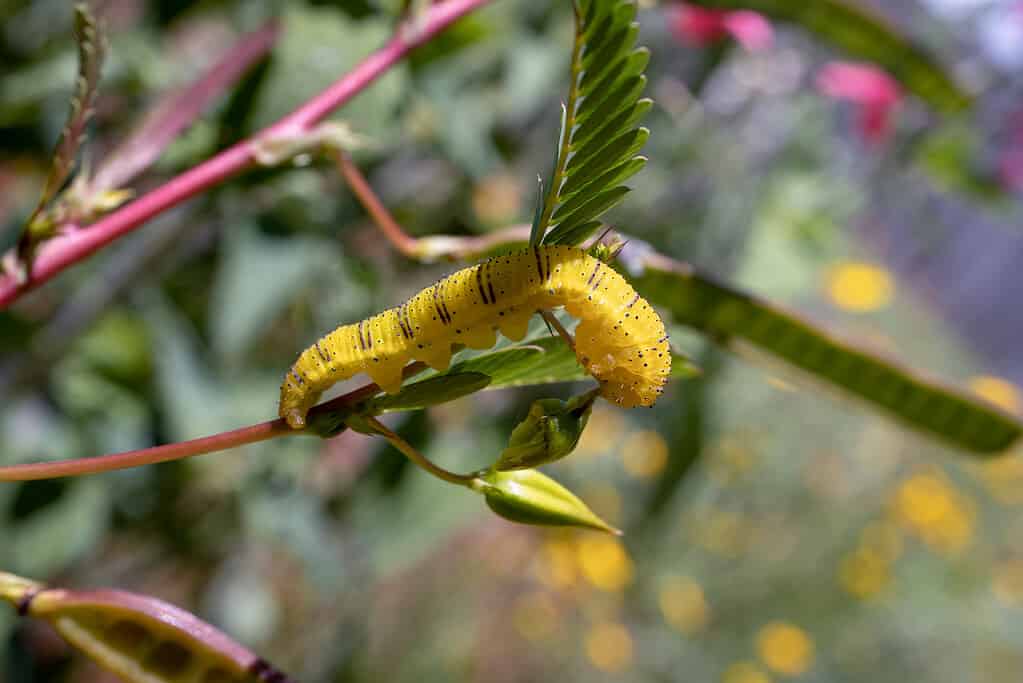
These caterpillars change color depending on what they eat. Their diet is also what gives them their toxic traits.
©DrWD40/ via Getty Images
Cloudless sulphur caterpillars are primarily green, though they also generally have blue and yellow lines along their sides. Interestingly, their color can shift depending on what they eat, and if they consume the yellow blossoms of the cassia plant, they will turn yellow in color.
The cloudless sulphur is not a permanent resident of Wisconsin due to its inability to withstand the harsh northern winters. Its appearance in the state is not a yearly occurrence, making it a rare and special sighting in the region.
Prior to transforming into a fully-fledged sulphur butterfly, this caterpillar primarily feeds on the leaves and blossoms of plants belonging to the Senna and Cassia families. The poisonous nature of these plants gives the caterpillars a toxic defense mechanism against potential predators.
4. Canadian Tiger Swallowtail Caterpillar (Papilio canadensis)
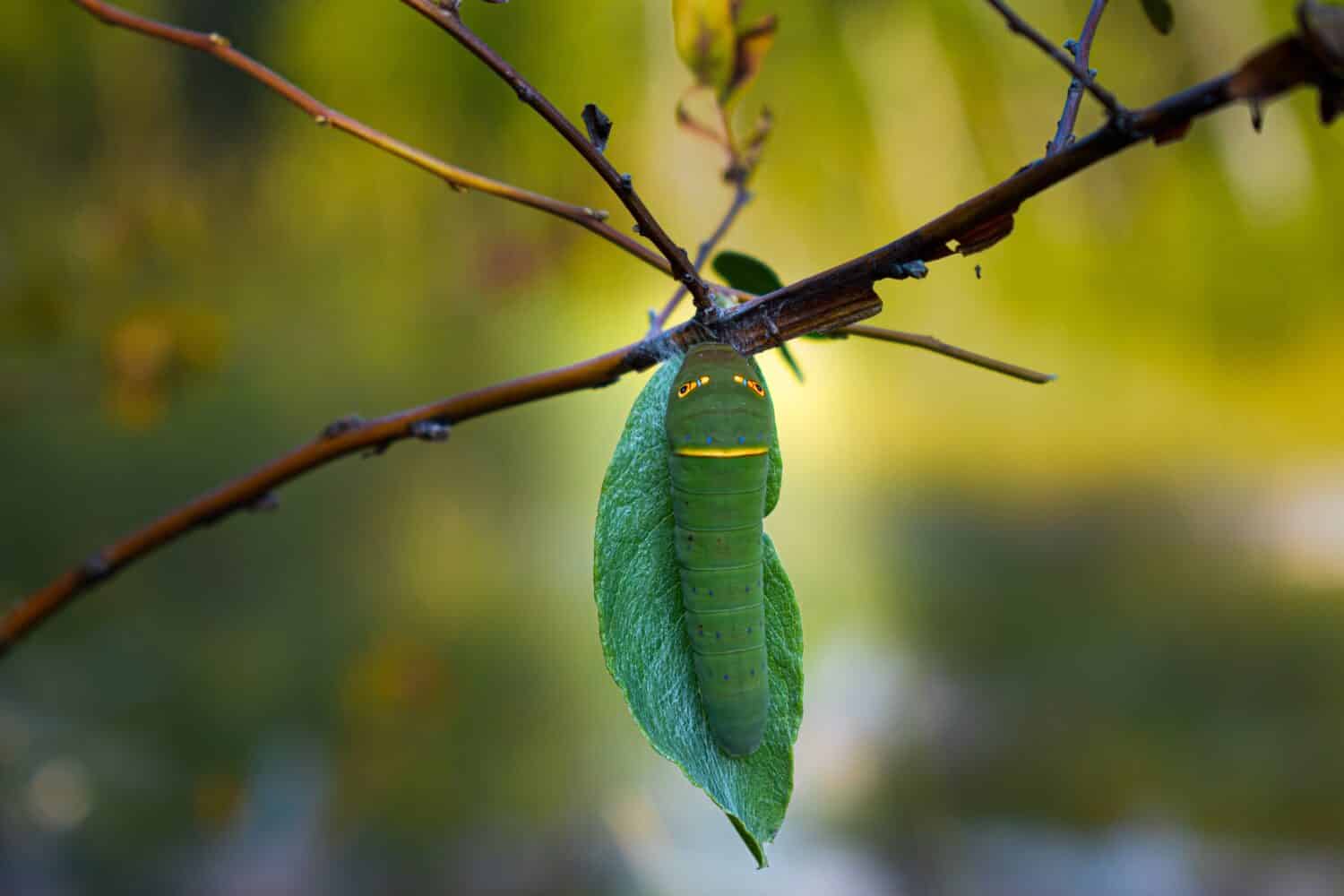
One of the most unique caterpillars in Wisconsin is the Canadian
tiger
swallowtail found in the northern parts of the state.
©NfaPhotoArt/Shutterstock.com
Canadian tiger swallowtail and eastern tiger swallowtail butterflies are very similar. The cold-resistant Canadian tiger swallowtail butterfly is a familiar sight in the northern regions of Wisconsin. Its cousin, the eastern tiger swallowtail, takes its place in the southern areas.
As the caterpillars of Canadian tiger swallowtail grow, their skin adopts a green color. The head section features a pair of markings resembling orange and black eyes. Behind these false eyes, you can observe a distinctive yellow band encircling their bodies.
These young creatures enjoy munching on the foliage of the plants they inhabit. You can generally find them in forested regions or clearings close to wooded spaces.
They are not poisonous and pose no threat to humans!
5. Spring Azure Caterpillar (Celastrina argiolus)
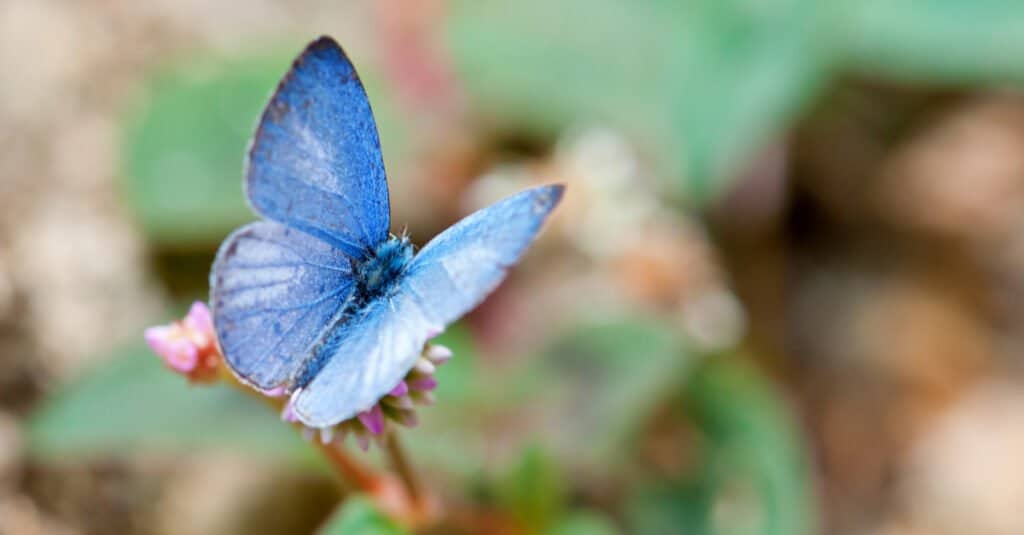
These caterpillars morph into gorgeous blue butterflies that only live a few days before dying.
©johannviloria/Shutterstock.com
The spring azure butterfly is among the first to appear in Wisconsin every year.
The caterpillar’s color can vary, appearing in tones ranging from green and brown to a soft pinkish-green. It has faint horizontal stripes along each segment of its back, allowing it to camouflage seamlessly amidst the flowers of a dogwood bloom.
When it comes to their diet, spring azure caterpillars prefer the buds of the flowering dogwood, although they aren’t too picky and will also enjoy blueberries, viburnums, and other plants.
The spring azure is non-toxic. So, these caterpillars make up a significant part of the diet of spiders, birds, and other insects.
6. Red Admiral Caterpillar (Vanessa atalanta)
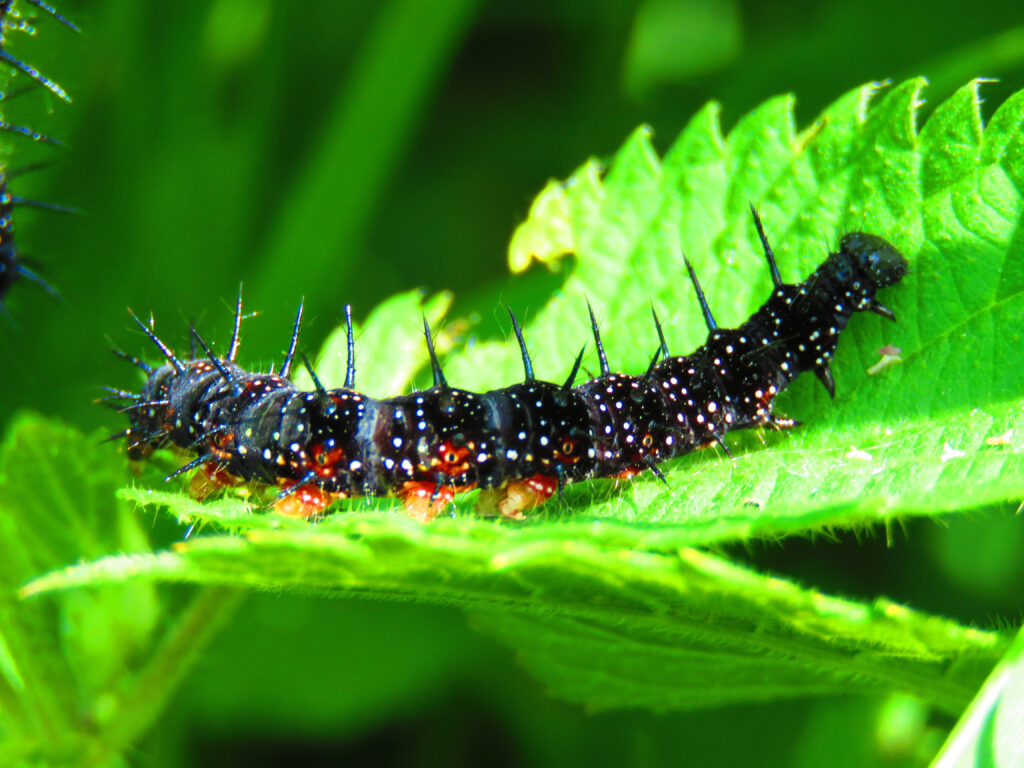
This frightening caterpillar is loaded with spikes. However, it is not poisonous and entirely safe to handle.
©Przemyslaw Muszynski/Shutterstock.com
Red admiral caterpillars undergo several changes in appearance throughout their developmental stages. They might exhibit a range of colors, including black, a greenish tint, a pale shade, or brown, adorned with numerous tiny bumps and dark, pointed projections.
This caterpillar primarily feeds on vegetation found within the nettle family, also known as Urticaceae.
Despite their somewhat intimidating appearance that might suggest potential harm or toxicity, handling them is actually entirely safe.
7. Question Mark Caterpillar (Polygonia interrogations)
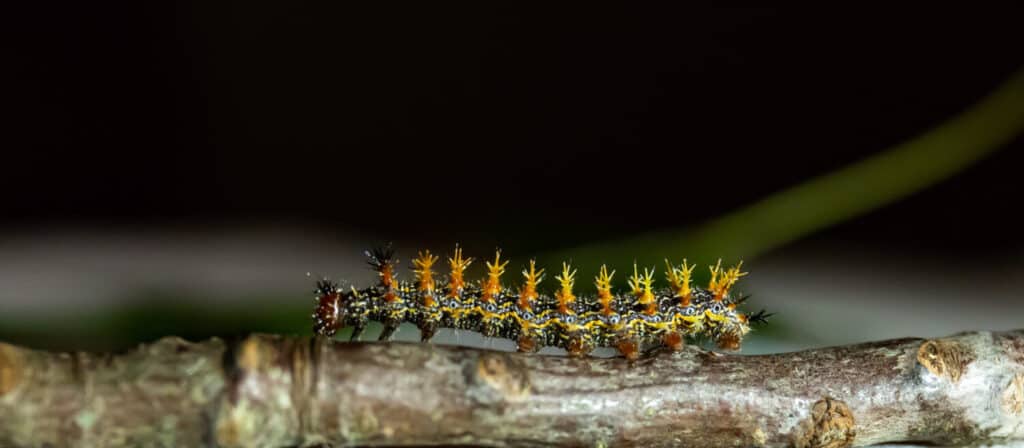
Another common caterpillar in Wisconsin is the question mark caterpillar. This caterpillar eventually grows to be the beautiful question mark butterfly.
©Dank Pics/Shutterstock.com
The question mark caterpillar is characterized by its dark body and a rich, reddish-brown head. This dark body has colorful hairs that protrude from its body in yellow, orange, or red. These hairs extend from head to tail and are accompanied by tiny white dots.
These caterpillars eat American elm, false nettle, hackberry, and hops.
Their body is equipped with spines that serve as a defensive mechanism against predators. Thankfully, these spines are not laced with venom, making the caterpillar safe to handle.
8. Monarch Caterpillar (Danaus plexippus)
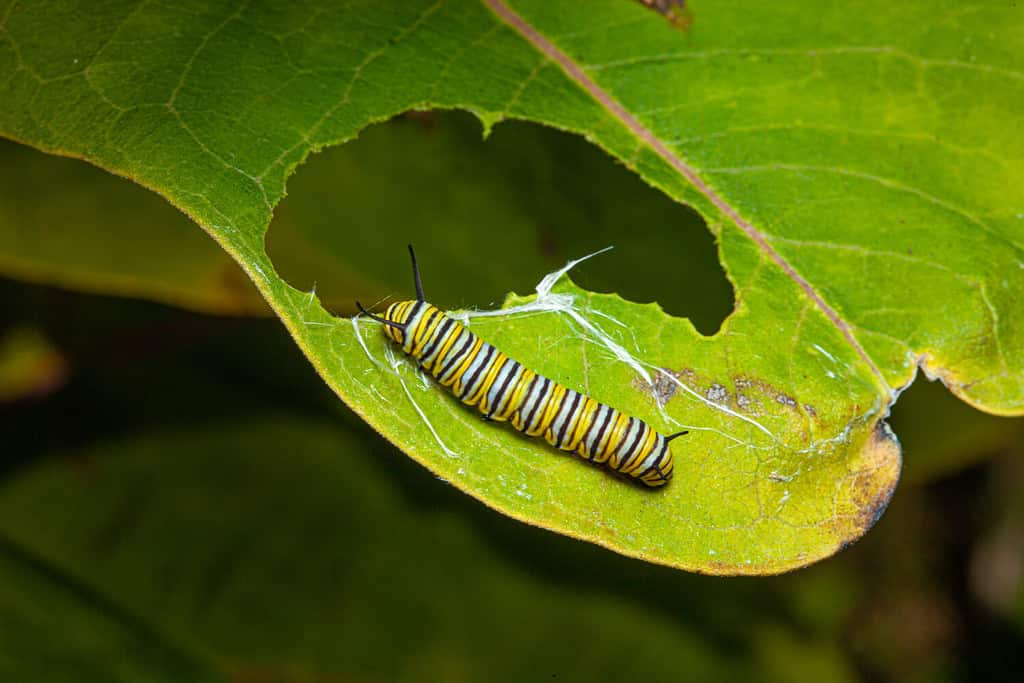
Monarchs are less common in Wisconsin nowadays than they used to be due to deforestation and habitat loss.
©K Hanley CHDPhoto/Shutterstock.com
In the past, the Midwestern region, including Wisconsin, was the breeding ground for over 85 percent of the eastern monarch butterfly migrating group. However, due to diminishing habitats, this number has sadly significantly decreased.
The monarch caterpillar can be identified by its yellow, black, and white striped pattern, growing up to two inches before transforming into a butterfly. The life cycle of these butterflies is heavily dependent on milkweed plants, the sole food source for the larvae.
Be cautious! The toxins from the milkweed plant make the monarch caterpillars poisonous!
9. American Dagger Moth Caterpillar (Acronicta Americana)
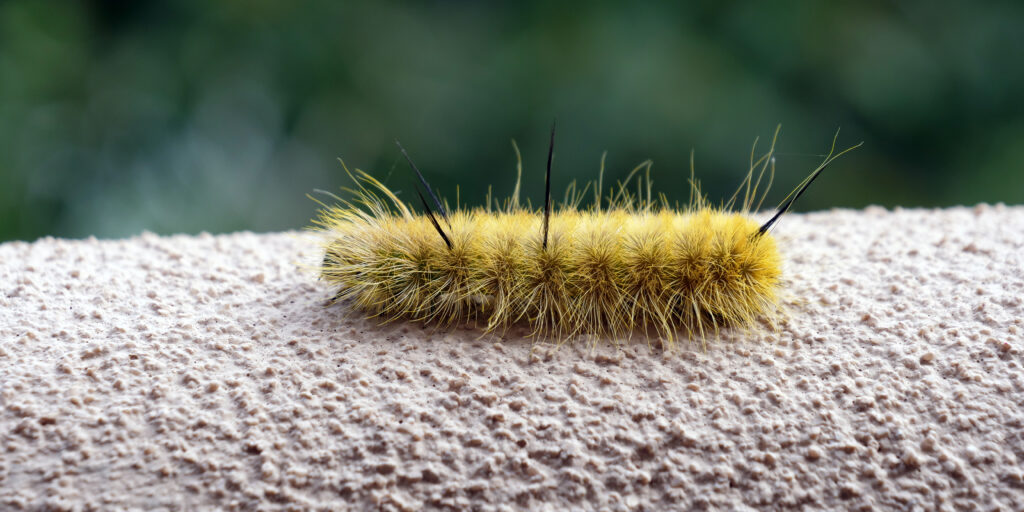
These caterpillars are extremely toxic, and you should NEVER touch their spines.
©Martha Marks/Shutterstock.com
The American dagger moth caterpillar, when young, features a dense covering of yellow bristles. As it ages, these bristles may turn a light yellow or white. Notably, fine black bristles can be found on their first and third abdominal sections, and a distinctive black tuft adorns the eighth section.
Throughout the caterpillar’s growth period, they thrive on the foliage of various hardwood trees such as alder, ash, elm, maple, oak, and willow. You can find them in many locations, including gardens, parks, and woodlands, indulging in their leafy meals.
Be wary of their sharp, dagger-like bristles, as they can release toxins upon contact with the skin. Even a dislodged bristle from the caterpillar can potentially irritate.
10. Buck Moth Caterpillar (Hemileuca maia)
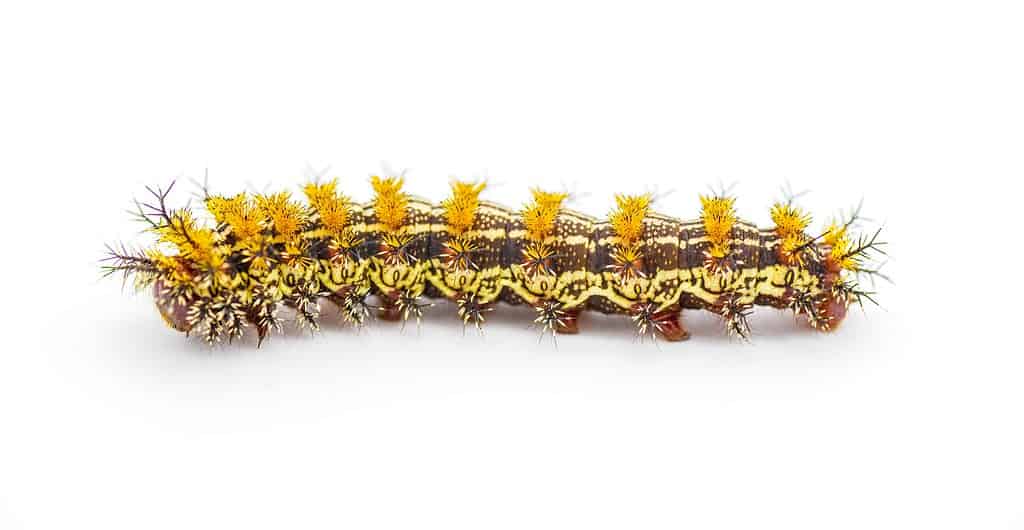
These caterpillars can grow to surprisingly large sizes of up to 2.5 inches!
©Chase D’animulls/Shutterstock.com
Mature buck moth caterpillars are predominantly black and prickly, although their bodies can sometimes be densely speckled with minuscule white dots, making them appear almost whitish. Their bodies showcase rows of bumps adorned with grouped spines, with the ones on the upper side being lengthier. These caterpillars can attain a length of nearly 2.5 inches.
Their primary food sources are various types of oak trees, such as scrub oak, live oak, and blackjack oak.
It’s important to note that the caterpillar’s spiky hairs are venomous, being hollow structures linked to poison glands beneath their skin. Touching them can induce a sensation similar to a burn, resulting in swelling and pain comparable to that of a bee sting.
11. Giant Leopard Moth Caterpillar (Hypercompe scribonia)
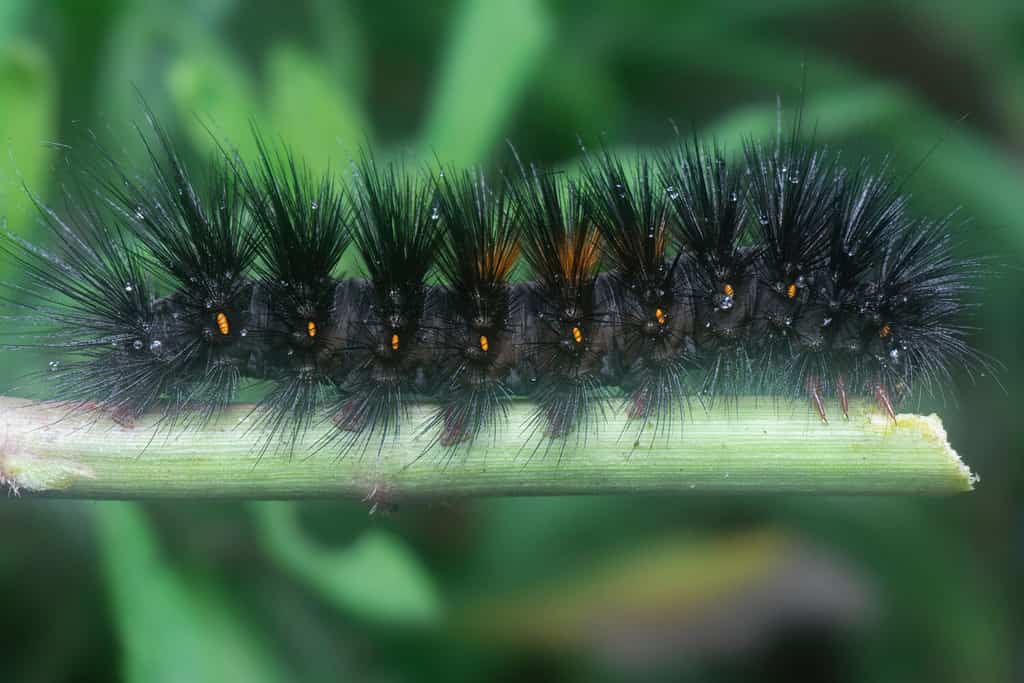
The larvae of the giant
leopard
moth are large, furry caterpillars. However, they are not poisonous!
©Young Swee Ming/Shutterstock.com
In its larval stage, the giant leopard moth can reach up to two inches long. Now that is a big caterpillar! Giant leopard moth caterpillars boast a body adorned with glossy black hairs. Their hairy appearance and bristles are non-urticant, meaning they do not detach and irritate the skin of predators upon contact.
The larvae of the giant leopard moth have a diverse diet, enjoying a variety of low-growing plants and shrubs, including but not limited to banana, cherry, cabbage, dandelion, and maple trees.
These caterpillars are not poisonous, so you can admire them without worrying about being poisoned!
12. Imperial Moth Caterpillar (Eacles imperialism)

As a caterpillar, the imperial moth spends most of its time in the trees, feeding.
©Matt Jeppson/Shutterstock.com
Imperial moth caterpillars start off as small, bright orange creatures with noticeable black spikes, measuring about half an inch in length. As they grow, they transform into chunky caterpillars, exhibiting colors ranging from green and brown to almost black, and can be as long as three to five inches. Some of the brown varieties are marked with distinct orange spots.
These caterpillars feed on a wide array of trees, although they exhibit a particular fondness for pines, oaks, and maples.
Imperial moth caterpillars are harmless.
13. Puss Caterpillar (Megalopyge opercularis)
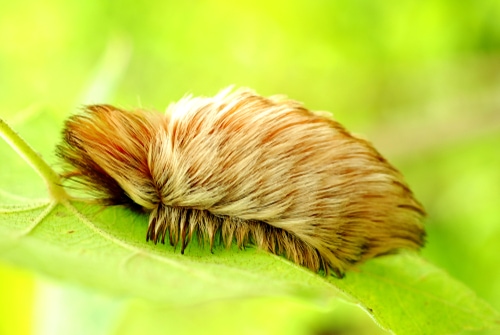
I know what you are thinking: there is no way that is a caterpillar. But, in fact, this is the puss caterpillar.
©Adriana Margarita Larios Arellano/Shutterstock.com
Puss caterpillars, alternatively known as asp caterpillars, have got their name owing to the powerful sting they can deliver. These caterpillars have dense, soft bristles covering their body, resembling a cat’s fur.
These caterpillars feed on the foliage of various trees and bushes, such as oak, pecan, and elm. Throughout their growth period, they undergo several skin-shedding processes.
It’s important to approach them cautiously, as their thick fur hides toxic bristles capable of causing severe itching and allergic responses in individuals touching them. In more severe scenarios, the toxins in the bristles can lead to serious health issues, including chest pains, respiratory difficulties, and muscle spasms.
14. Saddleback Caterpillar (Acharia stimulea)
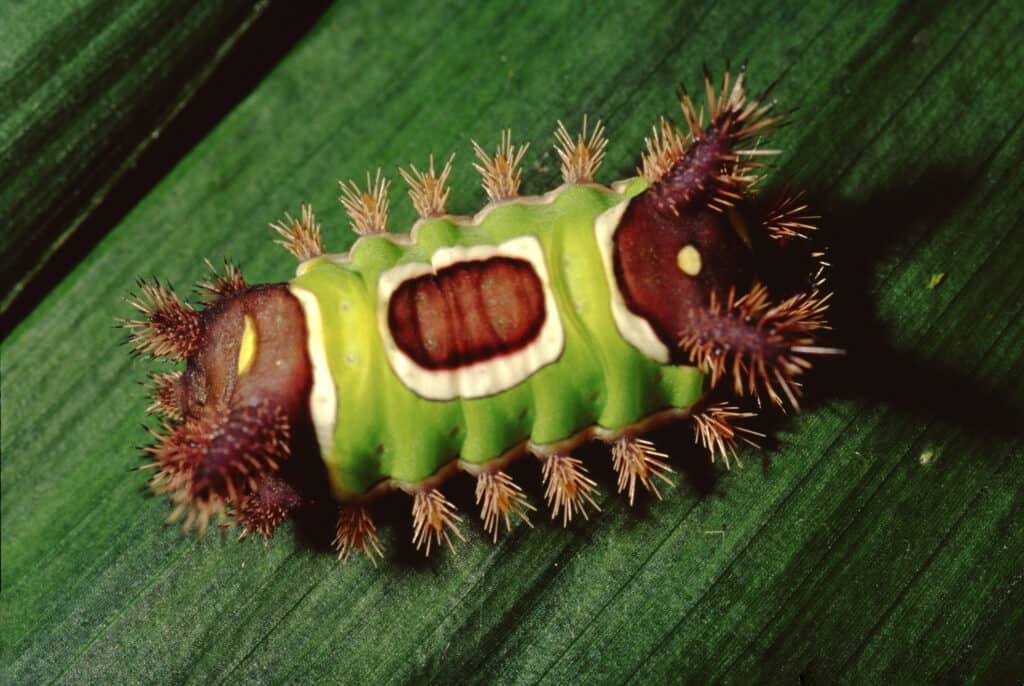
The green saddle marking on the back of the saddleback caterpillar is what gives it its name.
©Liz Weber/Shutterstock.com
Saddleback caterpillars are distinctive due to a unique brown marking, resembling a saddle, that adorns their green bodies. They’ve earned the nickname slug caterpillars owing to the absence of small hooks on their abdominal legs, a feature commonly found in other caterpillars, and their notably short, six-jointed legs.
These caterpillars are known to feed on a wide range of plants, such as apples, asters, blueberries, and citrus plants, among others.
These caterpillars possess sharp spines on their bodies capable of delivering a painful sting.
15. Monkey Slug Caterpillar (Phobetron pithecium)
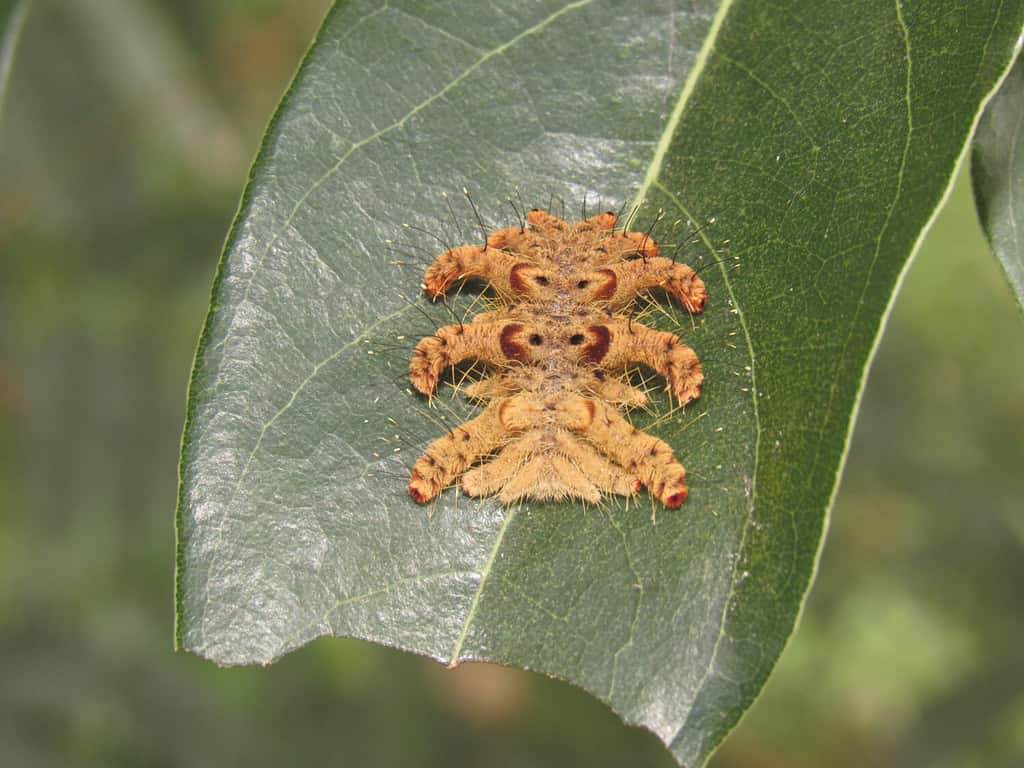
Hag moth caterpillars, also called monkey slugs, look more like an extraterrestrial being than a caterpillar.
©Fabio Ara/Shutterstock.com
Last but not least is one of the most unique-looking caterpillars out there: The monkey slug caterpillar! This larva transforms into the hag moth and bears a peculiar resemblance to a fluffy, brown starfish with a slightly elongated shape. This odd appearance of the oak slug moth’s larvae is coupled with the presence of stinging bristles. Remarkably, they don’t have the typical prolegs found in many caterpillars, but instead, have suckers that allow them to move in a slug-like manner.
These larvae are often found residing on the lower surfaces of leaves, where they consume a range of deciduous trees and shrubs, including apple, ash, birch, cherry, chestnut, and dogwood varieties.
It’s important to note that the monkey slug caterpillar is poisonous!
Regions in Wisconsin with the Most Caterpillars
Caterpillars are prevalent in various regions across Wisconsin, especially in areas abundant in greenery and diverse plant life. Here are some of the regions where you might find the highest populations of these creatures:
- Chequamegon-Nicolet National Forest: As the largest forest in the state, it is a hotspot for various caterpillar species. The rich diversity in plants makes it a buffet for these creatures, supporting their growth and transformation into butterflies and moths.
- Northwoods: Situated in the northern part of the state, it offers many green spaces where caterpillars thrive. The lush forests provide ample food sources, fostering a massive population of these intriguing insects.
- Driftless Area: This region features a blend of meadows and forests, creating a nurturing habitat for a variety of caterpillar species. The diverse landscape is a haven where they can find ample nourishment and safe spots for metamorphosis.
- City Parks and Backyards: Don’t overlook the urban areas and your own backyard! Caterpillars frequently inhabit gardens and parks within cities, where flowering plants and shrubs provide food. Setting up a butterfly garden with native plants can even turn your backyard into a mini sanctuary for caterpillars.
Summary of Caterpillars Found in Wisconsin
| Caterpillar | Type of Caterpillar | Poisonous? |
|---|---|---|
| Pipevine Swallowtail Caterpillar | Butterfly | Yes |
| Baltimore Checkerpost Caterpillar | Butterfly | Yes |
| Cloudless Sulphur Caterpillar | Butterfly | Yes |
| Canadian Tiger Swallowtail Caterpillar | Butterfly | No |
| Spring Azure Caterpillar | Butterfly | No |
| Red Admiral Caterpillar | Butterfly | No |
| Question Mark Caterpillar | Butterfly | No |
| Monarch Caterpillar | Butterfly | Yes |
| American Dagger Moth Caterpillar | Moth | Yes |
| Buck Moth Caterpillar | Moth | Yes |
| Giant Leopard Moth Caterpillar | Moth | No |
| Imperial Moth Caterpillar | Moth | Yes |
| Puss Caterpillar | Moth | Yes |
| Saddleback Caterpillar | Moth | Yes |
| Monkey Slug Caterpillar | Moth | Yes |
The photo featured at the top of this post is © NfaPhotoArt/Shutterstock.com
Thank you for reading! Have some feedback for us? Contact the AZ Animals editorial team.







